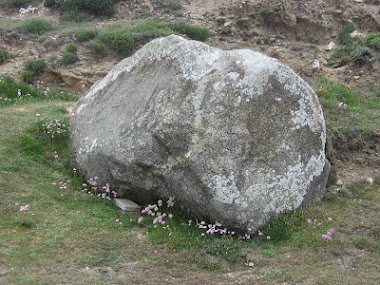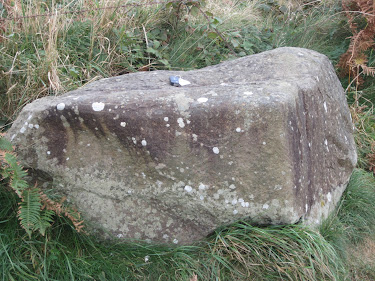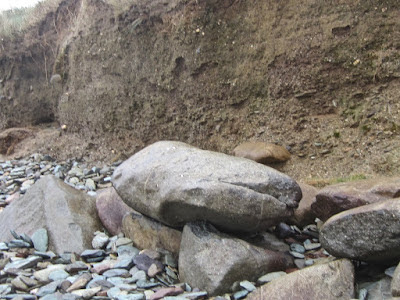11. The Ogof Golchfa geocaching boulder. This is a very large and well rounded erratic boulder, resting on the raised beach platform at Ogof Golchfa, near Porth Clais. It's made of a coarse gabbro -- which means it has probably come from St David's Head.
----------------------------
12. The Lydstep Steps erratic, south Pembrokeshire. I discovered this erratic close to the glacial deposits (Devensian?) where the path descends to the beach, near the famous Smugglers Cave. It's an igneous boulder, probably made of gabbro, so maybe it has come from St Davids Head. It is very different from the Carboniferous Limestone boulders that are prominent in the area.
----------------------------------
13. The clifftop seat, St Bride's Haven. An igneous erratic "pillar" on the clifftop a short distance to the east of St Brides Haven. Probably from the west end of the St Davids Peninsula. It has been utilised to make a pleasant seat for weary walkers on the Pembrokeshire Coast Path. In another context, this one might be mistaken for one of the Stonehenge bluestones........
-------------------------------
14. Igneous erratic boulder, Parc Mawr, near Bedd Morus, Newport. This large well-rounded and severely weathered boulder rests on a surface of Ordovician shales. It has probably not travelled far, but it may have travelled often....... it was moved a few years ago during some farming land clearance operations, and we can clearly see that part of it which was projecting through the ground surface.
------------------------------------
15. The Abermawr clifftop boulder. This is on the clifftop, adjacent to the Coast Path, very close to the turning area at the end of the road. It is made of dolerite, in an area where all the outcropping rocks are Ordovician sedimentaries.
-----------------------------------
16. Newport Cattle Pound boulder, found adjacent to the Cattle Pound on the Bedd Morris road. It's made of a rock type I don't recognize -- a very hard, fine grained igneous rock that looks like a basalt. I don't think it's from Pembrokeshire. I think the builders of the pound have tried to shape it for use in the building of the walls -- but they gave up because it was too hard and too resistant to break open........
----------------------------------------
17. Nevern Estuary boulder, found on the mud flats adjacent to the sand dunes. It rests on a surface of clay-rich till, along with several other boulders of the same type. It's made of a welded tuff which is difficult to provenance -- but it may have come from some of the igneous outcrops to the south of Newport. That's a bit of a puzzle, since all the other signs are that the ice flow here was from north towards south.
----------------------------------------
18. The Whitesands Boulder Bed. At the base of the Pleistocene sequence in Whitesands Bay there is a spectacular boulder bed with scores of large rounded igneous boulders visible as you walk along on the beach. They are mostly made of dolerite and gabbro -- probably locally derived. They rest on a raised beach platform, although they are not visibly embedded in raised beach deposits. Some are so well rounded that they must have been subjected to wave attack on the beach platform at some stage -- but others are broken and faceted, so they must be derived from old glacial deposits.
--------------------------
19. Mynydd Dinas igneous erratics. To the south of Carn Enoch and Garn Fawr there are abundant small rocky outcrops and large igneous erratics scattered across the landscape of Mynydd Dinas. Most of the boulders have not travelled far, but many of them are faceted and abraded, and so they have clearly been affected by ice -- maybe during several glacial episodes.
---------------------------------
20. Carreg Samson capstone, near Longhouse on the North Pembrokeshire coast. This cromlech has the most spectacular location in Pembrokeshire, and is almost as popular with visitors as Pentre Ifan! The geology has not been studied in detail, as far as I know -- but at least three of the stones are made of Ordovician dolerite, and the capstone, like one of the uprights, is made of what appears to be a rough volcanic agglomerate or ignimbrite, probably derived from one of the local igneous outcrops. This might be the rock referred to by BGS as a pyroclastic "crystal tuff" belonging to the Llanrian Volcanic Formation. A pit was discovered beneath the capstone, and it has been assumed the this was where the capstone was originally found before being lifted and propped up in its present position.
--------------------------------










No comments:
Post a Comment
Please leave your message here